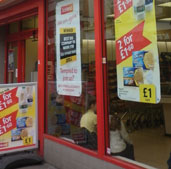Among the findings of the UK Retail Fraud Survey – 2014, sponsored by Kount –
About half, 51 per cent of the average loss prevention team works in stores and 49pc in head office. Mass merchandisers have the highest store presence at 83% and small format speciality stores have the majority of their loss prevention team based at head office. Manned guards are used by about two-thirds, 65pc of all retailers, but rarely in all stores. Only 8pc of retailers use them in all of their stores. The highest proportion of retailers (22pc) use them in less than 10pc of their stores.
Shrink levels have increased this year by over 22.2 per cent from 0.9 per cent of sales last year to 1.1 per cent of sales this year. That’s estimated as £5.03 billion loss to the industry.
• The shrinkage rates vary by retail sector from department stores at 2.4 per cent of sales to home shopping retailers at 0.6 per cent of sales.
• Most retailers still treat store and online loss prevention separately. Typically the Head of Loss Prevention focuses on stores and online shrinkage is managed separately. However, employees, customers and fraudsters do not make this distinction.
• With the growth of multi-channel retailing, where transactions cross organisational boundaries, survey organisers anticipate the wider use of a cross-functional, holistic approach to loss prevention. Retailers expect online sales to increase from 12 per cent currently to 31 per cent of total business over the next three
years. As that happens, adoption of an increasingly” joined up” philosophy to all loss prevention; store and online, is expected.
• The biggest area of store loss remains shoplifting, followed by theft or fraud from employees. American retailers generally put losses owing to staff ahead of losses owing to external shrink, as identified last year in the US Retail Fraud Survey – 2013.
• The biggest area of online loss remains, overwhelmingly, from the fraudulent use of credit cards (43 per cent), followed again by third party fraud payment (15 per cent).
• Reflecting on recent online fraud events, 33 per cent of retailers identify fraud detection capabilities as their biggest concern.
• Spend on store based and online fraud prevention continues to even up. Store spend continues to fall whilst online continues to increase.
• Store fraud prevention spend has fallen from 0.7 per cent of sales in 2012 and 0.6 per cent in 2013 to 0.5 per cent in 2014. Meanwhile online fraud prevention spend has increased from 0.3 per cent of sales in 2012 and 0.4 per cent in 2013, to 0.43 per cent this year. This reflects the growing importance of online trading to retailers.
• Return fraud is up 125 per cent, costing retailers an average of 0.9 per cent of sales this year compared with an average of 0.4 per cent last year.
Don Bush of Kount said: “I talk with hundreds of merchants operating online and often hear the comment, “I don’t have a fraud problem.” Well, they may or they may not, but they better be ready for fraudsters to strike and how many good orders are they turning away for fear of fraud? As this survey report illustrates the percentage of online retailers that do not use a fraud system, whether internal or 3rd party, designed for online fraud reduction, is staggering. Whilst ecommerce grew at a healthy 18pc in 2013, cybercrime grew at about 23pc in the same period. It’s not if you will be targeted and hit by fraudsters or cyber criminals, it’s really a matter of when.”
Contact
For more about the survey or to take part in 2015 contact – Paul Bessant of Retail Knowledge: [email protected], or phone 0207 100 3 999.










